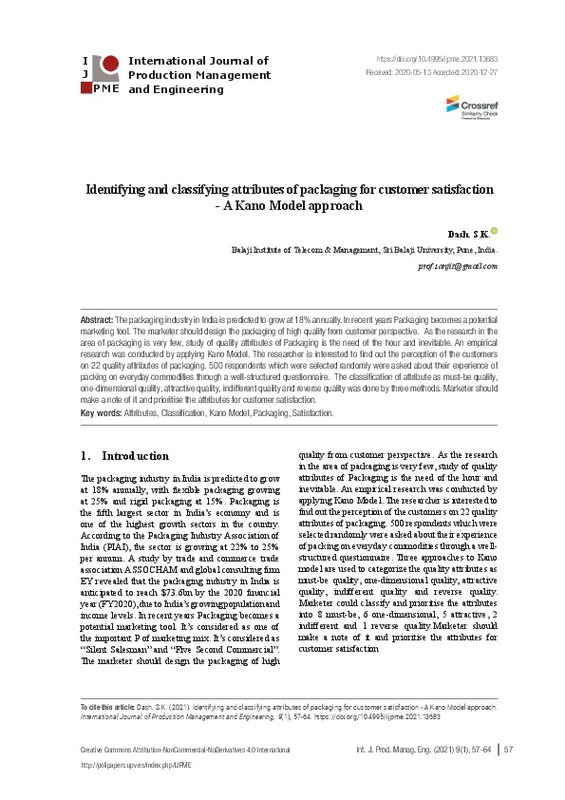Bakhitar, A.,Hannan, A., Basit, A., Ahmad, J.(2015). Prioritization of value based services of software by using AHP and fuzzy KANO model. International Conference on Computational and Social Sciences, 8, 25- 27.
Basfirinci, C., Mitra, A. (2015). A cross cultural investigation of airlines service quality through integration of Servqual and the Kano model. Journal of Air Transport Management, 42(1), 239-48. https://doi.org/10.1016/j.jairtraman.2014.11.005
Berger, C., Blauth, R., Boger, D., Bolster, C., Burchill, G., DuMouchel, W., Pouliot, F., Richter, R., Rubinoff, A., Shen, D., Timko, M., Walden, D. (1993). Kano's methods for understanding customer-defined quality. The Center for Quality of Management Journal, 2(4), 2-36.
[+]
Bakhitar, A.,Hannan, A., Basit, A., Ahmad, J.(2015). Prioritization of value based services of software by using AHP and fuzzy KANO model. International Conference on Computational and Social Sciences, 8, 25- 27.
Basfirinci, C., Mitra, A. (2015). A cross cultural investigation of airlines service quality through integration of Servqual and the Kano model. Journal of Air Transport Management, 42(1), 239-48. https://doi.org/10.1016/j.jairtraman.2014.11.005
Berger, C., Blauth, R., Boger, D., Bolster, C., Burchill, G., DuMouchel, W., Pouliot, F., Richter, R., Rubinoff, A., Shen, D., Timko, M., Walden, D. (1993). Kano's methods for understanding customer-defined quality. The Center for Quality of Management Journal, 2(4), 2-36.
Brown, G.H. (1950). Measuring consumer attitudes towards products. Journal of Marketing, 14(5), 691-98. https://doi.org/10.1177/002224295001400505
Chaudha, A., Jain, R., Singh, A.R., Mishra, P.K. (2011). Integration of Kano's Model into Quality Function Deployment (QFD). Journal Advice Manufacture Technology, 53, 689-698. https://doi.org/10.1007/s00170-010-2867-0
Cole, R.E. (2001). From continuous improvement to continuous innovation. Quality Management Journal, 8(4), 7-21. https://doi.org/10.1080/10686967.2001.11918977
Dash, S.K. (2019). Application of Kano Model in Identifying Attributes. A Case Study on School Bus Services. International Journal of Management Studies, 6(1), 31-37. https://doi.org/10.18843/ijms/v6i1(3)/03
Dziuba, S.T., Śron, B. (2014). FAM-FMC system as an alternative element of the software used in a grain and flour milling enterprise. Production Engineering Archives, 4(3),29-31. https://doi.org/10.30657/pea.2014.04.08
Ernzer, M., Kopp, K.(2003). Application of KANO method to life cycle design. IEEE Proceedings of Eco Design: Third International Symposium on Environmentally Conscious De-sign and Inverse Manufacturing, Tokyo Japan, December 8-11, 383-389. https://doi.org/10.1109/ECODIM.2003.1322697
Feigenbaum, A.V. (1991).Total Quality Control. McGraw-Hill. Fundin, A., Nilsson, L. (2003). Using Kano's theory of attractive quality to better understand customer satisfaction with e-services. Asian Journal on Quality, 4(2), 32-49. https://doi.org/10.1108/15982688200300018
Friman, M., Edvardsson, B. (2003). A content analysis of complaints and compliments. Managing Service Quality, 13(1), 20-26. https://doi.org/10.1108/09604520310456681
Garvin, D.A. (1987). Competing on the eight dimensions of quality. Harvard Business Review, 65(6), 101-109.
Hanan, M., Karp, P. (1989). Customer satisfaction, how to maximise, measure and market your company's "ultimate product". AMACOM.
Herzberg, F., Bernard, M., Snyderman, B.B. (1959). The Motivation to Work. John Wiley and Sons.
Hoch, S.J., Ha, Y.W. (1986). Consumer learning: advertising and the ambiguity of product experience. Journal of Consumer Research, 13, 221-33.
https://doi.org/10.1086/209062
Johnson, M.D., Nilsson, L. (2003). The Importance of Reliability and Customization from Goods to Services. Quality Management Journal, 10(1), 8-19. https://doi.org/10.1080/10686967.2003.11919049
Kano, N., Seraku, N., Takahashi, F., Tsuji, S. (1984). Attractive Quality and Must-Be Quality. Journal of the Japanese Society for Quality Control, 41, 39-48.
Kapalle, P.K, Lehmann, D.R. (1995). The effects of advertised and observed quality on expectations about new product quality. Journal of Marketing Research, 32(8), 280-90. https://doi.org/10.1177/002224379503200304
Lee, M.C., Newcomb, J.F. (1997). Applying the Kano methodology to meet customer requirements: NASA's microgravity science program. Quality Management Journal, 4(3), 95-110. https://doi.org/10.1080/10686967.1997.11918805
Löfgren, M. (2005). Winning at the first and second moments of truth: An exploratory study. Journal of Service Theory and Practice, 15(1), 102-15. https://doi.org/10.1108/09604520510575290
Löfgren, M., Witell, L. (2005). Kano's Theory of Attractive Quality and Packaging. Quality Management Journal, 12(3), 7-20. https://doi.org/10.1080/10686967.2005.11919257
Matzler, K., Hinterhuber, H.H., Bailom, F., Sauerwein, E. (1996). How to delight your customers. Journal of Product & Brand Management, 5(2), 6-18. https://doi.org/10.1108/10610429610119469
Miarka, D., Żukowska, J., Siwek, A., Nowacka,A., Nowak, D. (2015). Microbial hazards reduction during creamy cream cheese production. Production Engineering Archives, 6(1), 39-44. https://doi.org/10.30657/pea.2015.06.10
Nelson, P. (1970), Information and consumer behaviour. Journal of Political Economy, 78, 311-29. https://doi.org/10.1086/259630
Nilsson-Witell, L, Fundin, A. (2005). Dynamics of service attributes: a test of Kano's theory of attractive quality. International Journal of Service Industry Management, 16(2), 152-168. https://doi.org/10.1108/09564230510592289
Parasuraman, A. (1997). Reflections on gaining competitive advantage through customer value. Academy of Marketing Science Journal, 25(2), 154-61. https://doi.org/10.1007/BF02894351
Parasuraman, A., Colby, C.L. (2001). Techno-Ready Marketing. Free Press.
Qiting, P., Uno, N., Kubota, Y. (2013). Kano Model Analysis of Customer Needs and Satisfaction at the Shanghai Disneyland. In Proceedings of the 5th Intl Congress of the Intl Association of Societies of Design Research, Tokyo, Japan. http://design-cu.jp/iasdr2013/papers/1835-1b.pdf Accessed on January 2021.
Sauerwein, E., Bailom, F., Matzler, K., Hinterhuber, H.H. (1996). The Kano Model: How to delight your Customers. Volume I of the IX. International Working Seminar on Production Economics, Innsbruck/Igls/Austria, February 19-23 1996, pp. 313-327. https://is.muni. cz/el/econ/podzim2009/MPH_MAR2/um/9899067/THE_KANO_MODEL_-_HOW_TO_DELIGHT_YOUR_CUSTOMERS.pdf
Shewhart, W.A. (1931). Economic Control of Quality of Manufactured Product. D. Van Nostrand Company, Inc.
Underwood, R.L., Klein, N.M. (2002). Packaging as Brand Communication: Effects of Product Pictures on Consumer Responses to the Package and Brand. Journal of Marketing Theory and Practice, 10(4), 58-68. https://doi.org/10.1080/10696679.2002.11501926
Underwood, R.L. Klein, N.M., Burke, R.R. (2001). Packaging communication: attentional effects of product imagery. Journal of Product & Brand Management, 10(7), 403-22. https://doi.org/10.1108/10610420110410531
Watson, G.H. (2003), "Customer focus and competitiveness", in Stephens, K.S. (Ed.), Six Sigma and Related Studies in the Quality Disciplines, ASQ Quality Press, Milwaukee, WI.
Williams, D. (2020). The future of the packaging industry in India. Packaging Gateway. https://packaging-gateway.com/features/futurepackaging-industry-in-india Accessed on January 2021.
Williams,H., Wikström,F., Löfgren.M. (2008). A life cycle perspective on environmental effects of customer focused packaging development." Journal of Cleaner Production, 16(7), 853-859. https://doi.org/10.1016/j.jclepro.2007.05.006
Woodruff, R.B. (1997). Customer value: the next source for competitive advantage. Journal of Academy of Marketing Science, 25(2), 139- 53. https://doi.org/10.1007/BF02894350
Zeithaml, V.A. (1988). Consumer perceptions of price, quality, and value: a means-end model and synthesis of evidence. Journal of Marketing, 52, 2-22. https://doi.org/10.1177/002224298805200302
[-]









